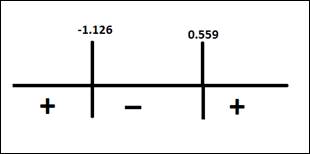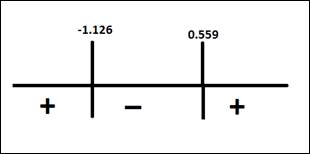
Concept explainers
a.
To find : The local extrema of the function
a.
Answer to Problem 27E
The maximum is at
Explanation of Solution
Given information :
The given function is
Calculation :
To find the local extrema first find the derivative of
Set
Substitute
Also, substitute
Therefore, the maximum is at
Hence,
The maximum is at
b.
To find : The interval on which the function
b.
Answer to Problem 27E
The function is increasing in the interval
Explanation of Solution
Given information :
The given function is
Calculation :
To find the interval on which the function is increasng first find the derivative of
Set
Use sign chart to get the interval in which the function is increasing

Therefore, the function is increasing in the interval
Hence,
The function is increasing in the interval
c.
To find : The interval on which the function
c.
Answer to Problem 27E
The interval on which the function is decreasing is
Explanation of Solution
Given information :
The given function is
Calculation :
To find the interval on which the function is decreasing first find the derivative of
Set
Use sign chart to get the interval in which the function is decreasing.

Therefore, the function is decreasing on the interval
Hence,
The function is decreasing in the interval
Chapter 5 Solutions
Calculus 2012 Student Edition (by Finney/Demana/Waits/Kennedy)
Additional Math Textbook Solutions
Introductory Statistics
University Calculus: Early Transcendentals (4th Edition)
Elementary Statistics
Elementary Statistics (13th Edition)
Elementary Statistics: Picturing the World (7th Edition)
A Problem Solving Approach To Mathematics For Elementary School Teachers (13th Edition)
 Calculus: Early TranscendentalsCalculusISBN:9781285741550Author:James StewartPublisher:Cengage Learning
Calculus: Early TranscendentalsCalculusISBN:9781285741550Author:James StewartPublisher:Cengage Learning Thomas' Calculus (14th Edition)CalculusISBN:9780134438986Author:Joel R. Hass, Christopher E. Heil, Maurice D. WeirPublisher:PEARSON
Thomas' Calculus (14th Edition)CalculusISBN:9780134438986Author:Joel R. Hass, Christopher E. Heil, Maurice D. WeirPublisher:PEARSON Calculus: Early Transcendentals (3rd Edition)CalculusISBN:9780134763644Author:William L. Briggs, Lyle Cochran, Bernard Gillett, Eric SchulzPublisher:PEARSON
Calculus: Early Transcendentals (3rd Edition)CalculusISBN:9780134763644Author:William L. Briggs, Lyle Cochran, Bernard Gillett, Eric SchulzPublisher:PEARSON Calculus: Early TranscendentalsCalculusISBN:9781319050740Author:Jon Rogawski, Colin Adams, Robert FranzosaPublisher:W. H. Freeman
Calculus: Early TranscendentalsCalculusISBN:9781319050740Author:Jon Rogawski, Colin Adams, Robert FranzosaPublisher:W. H. Freeman
 Calculus: Early Transcendental FunctionsCalculusISBN:9781337552516Author:Ron Larson, Bruce H. EdwardsPublisher:Cengage Learning
Calculus: Early Transcendental FunctionsCalculusISBN:9781337552516Author:Ron Larson, Bruce H. EdwardsPublisher:Cengage Learning





